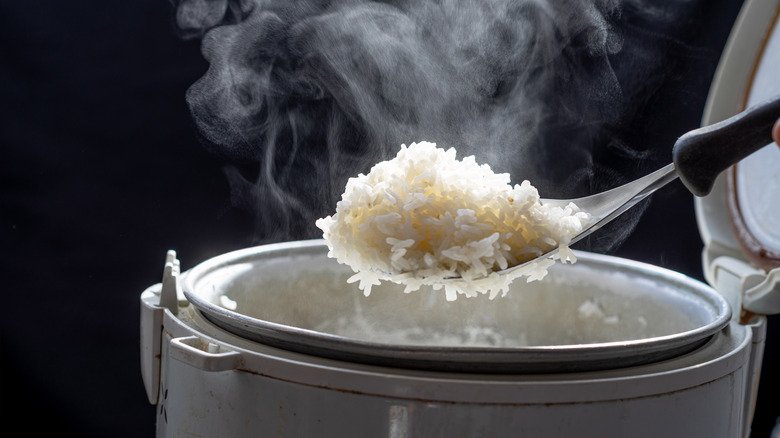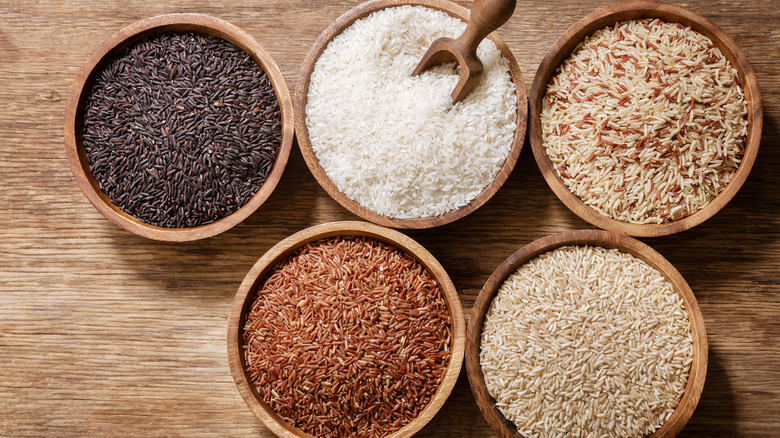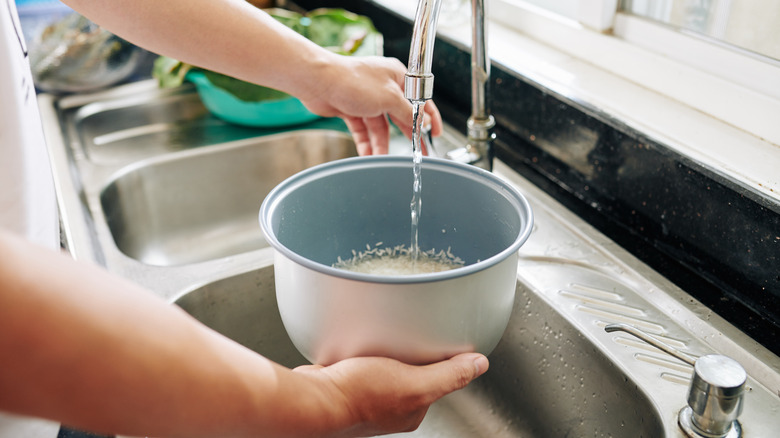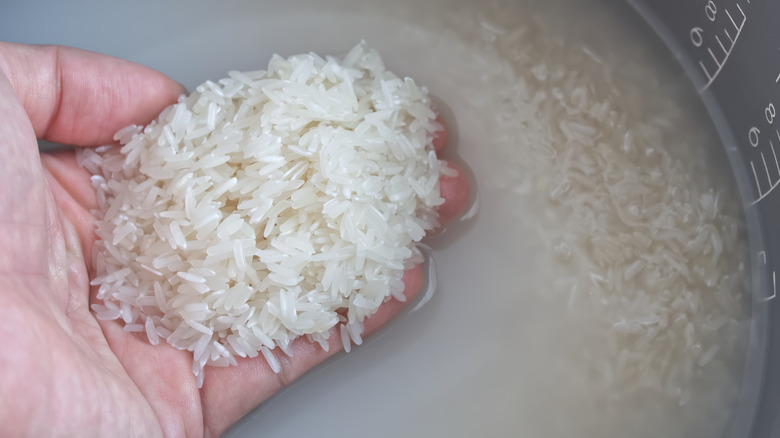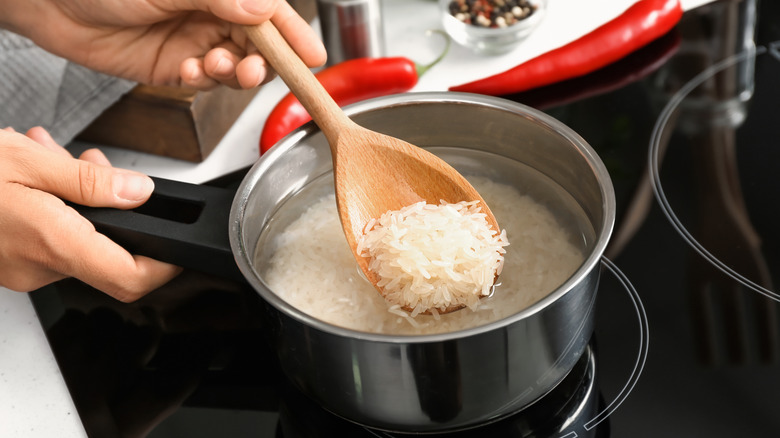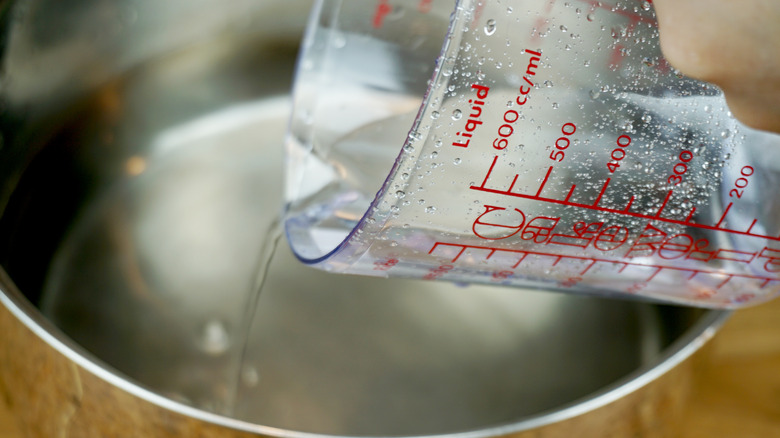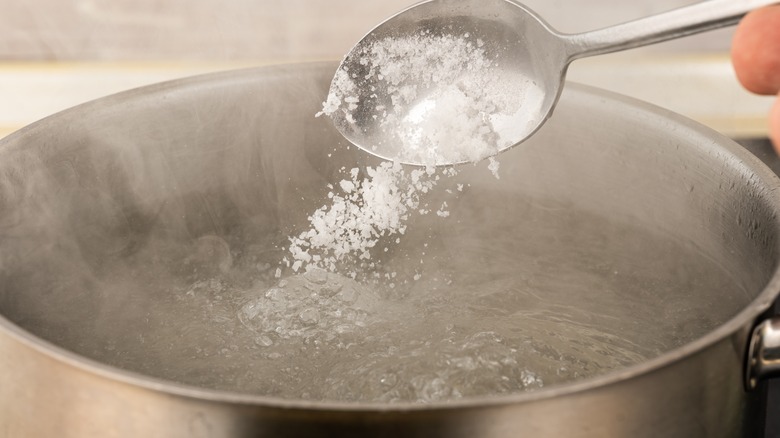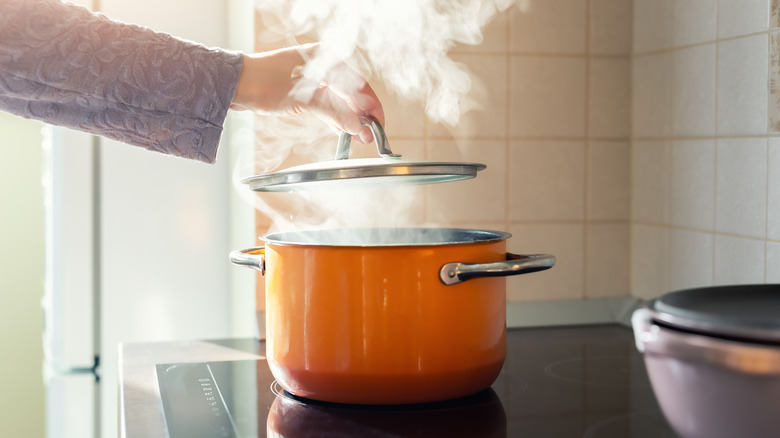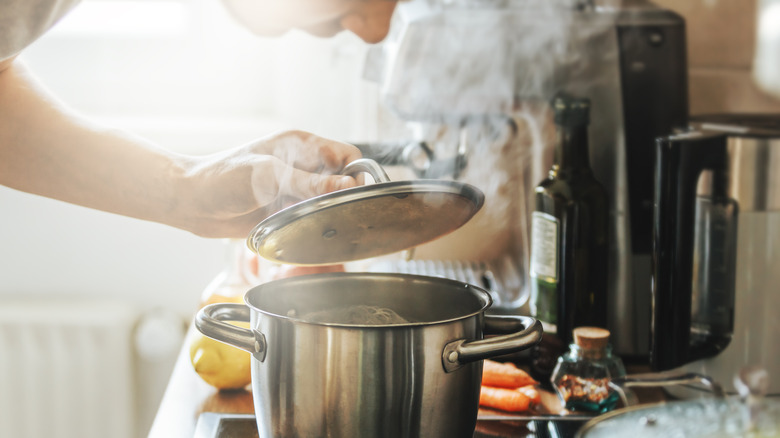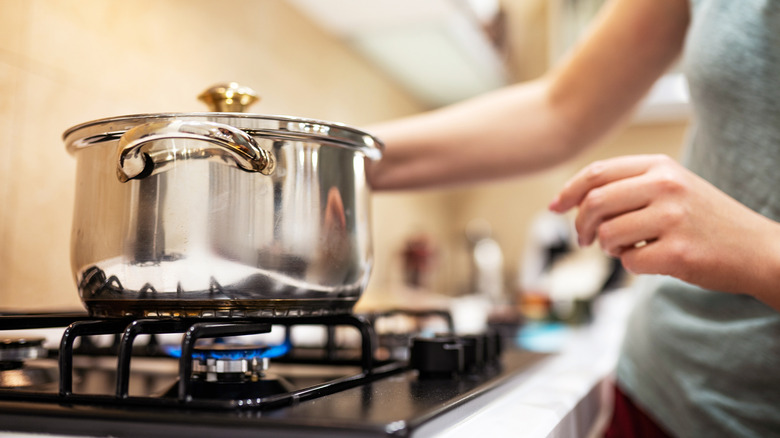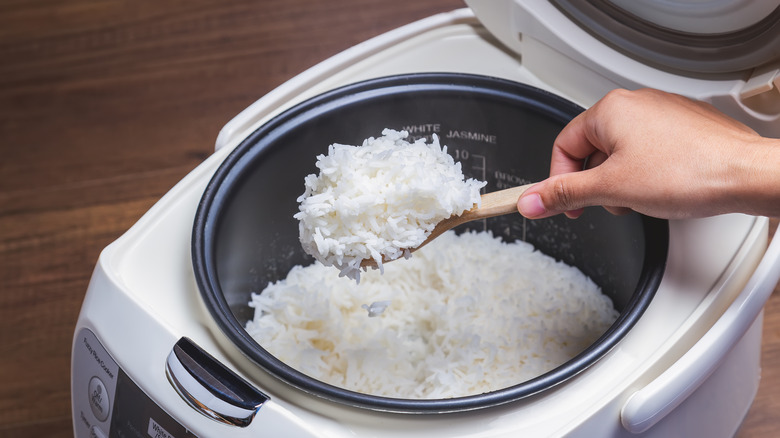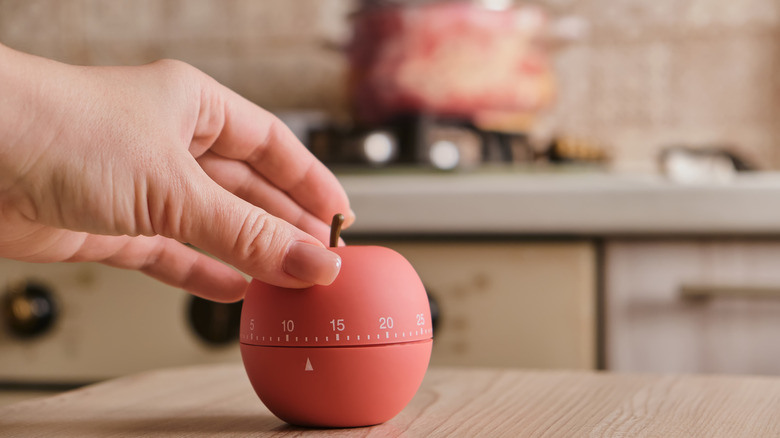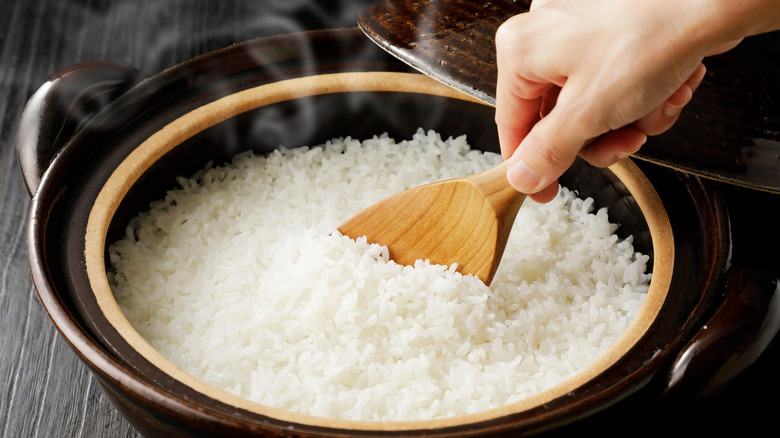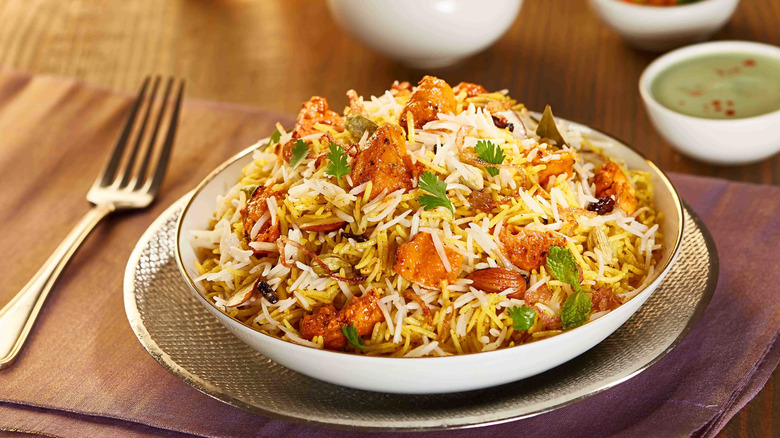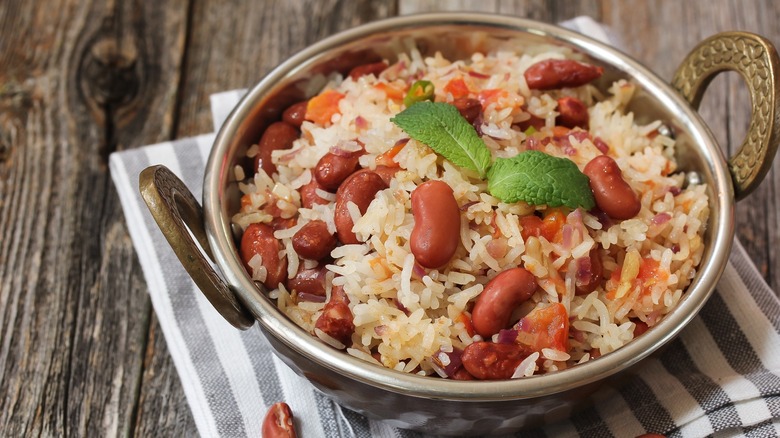Tips You Need When Cooking With Rice
Cooking rice should be easy, right? It's one of the world's most common foods, with approximately 480 million tons of milled rice produced annually, according to an article in Annals of the New York Academy of Sciences, which also noted rice is the staple food for approximately 3.5 billion people in the world. You can hardly find an international cuisine that doesn't make use of some sort of rice, whether you're ordering Asian takeout or dining at your favorite Mexican restaurant. Rice is affordable, filling, and makes an excellent blank canvas on which to paint an array of flavors — so why is it so difficult to get right?
If you struggle with replicating the fluffy grains that you're accustomed to enjoying at restaurants, and your rice always comes out either rock-hard or in gluey clumps, you might be falling prey to some of the most common mistakes made when cooking rice. Don't worry, though; it's easy to remedy those mistakes, so as long as you follow these tips.
Choose the right kind of rice
Don't make the mistake of assuming all rice is the same. Don't even make the mistake of assuming the only differences between the wide variety of rice available in the grocery store are the colors, even if you personally can't tell the difference between the white and brown rice at your favorite burrito chain. The type of rice you buy will greatly determine how you should cook and use it.
There are more than a dozen types of rice and not all can be cooked with just the trusty ol' 2-to-1 water-to-rice ratio that you probably have ingrained in your mind. Jasmine rice, for example, should be cooked using a 1.5-to-1 water-to-rice ratio. Wild rice, meanwhile, needs up to four cups of water for every cup of wild rice you want to cook. So, do yourself a favor the next time you cook rice; either follow your recipe's exact instructions as to what type of rice to buy or, if you're cooking without a recipe, follow the instructions on the rice's packaging.
Rinse the rice (or don't)
You've probably heard one side of the argument. Either you should or you shouldn't rinse your rice before cooking. However, no matter which rule you've heard all your life, it's not a good one. It's not true that you should rinse your rice every time and it's not true that you shouldn't rinse your rice every time. Instead, choosing to rinse or not to rinse will depend entirely on what type of rice you're cooking.
If you're cooking a starchy rice dish like risotto or cooking a short-grain rice, don't rinse it. You need the extra starch. If you're cooking a long-grain variety like Indian Basmati rice, though, rinsing is always recommended. For short-grain varieties, not rinsing preserves needed starch and also nutrients that some manufacturers may add to the rice in powder form, while, for long-grain varieties, rinsing can help kick off the cooking process while also removing any debris or chemicals.
Soak the rice when needed
Just like some varieties of rice need to be rinsed before cooking, to get the texture you want in a rice dish, some varieties need to be further soaked ahead of cooking. Basmati rice is one of these must-soak varieties, especially if you want a fluffy, light dish versus one that's gluey and gross. To guarantee your basmati rice is light and fluffy, rinse the rice and then soak it for at least 30 minutes. If you have some extra time on your hands, you can even soak the rice overnight, for up to eight hours in the refrigerator. After soaking, drain the rice before cooking. You can also toss the rice in cooking oil before adding it to your pot of water.
Beyond basmati rice, other types of rice that should be soaked include wild, wholegrain, glutinous, and Japanese short-grained rice (via The Guardian). In addition to kick-starting the cooking process, soaking certain types of rice will also help remove phytic acid, a naturally-occurring compound that prevents nutrient absorption (via HuffPost).
Start with cold water
If you boil your cooking water first and then add your rice, it'll cook faster, right? Not at all. While you might think that throwing your rice into a boiling pot of water, much like you would pasta, will result in a faster cooking time and rice that doesn't stick together, that's not the case at all. Instead, it might just leave you with rice that's absorbed all your hot water, but that's somehow still crunchy and hard.
Add your rice to cold water instead, and then bring the mixture up to a boil gradually. Since rice is starchy and dense, like potatoes, the cold water and gradual cooking process will ensure the rice cooks evenly, inside and out. The only time this is not the case is if you're cooking rice using the pasta method, wherein you just bring a big pot of salted water (much more than you would when normally cooking rice) to a boil, throw your rice in and let it cook until done — just like you would pasta.
Use the right rice-to-water ratio
While the 2-to-1 rice-to-water ratio is standard advice (even Food Network recommends it), it's not always the perfect rice-to-water ratio. Like most rice-cooking tips, it all comes down to what kind of rice you're cooking and what your end goal is. If you want a firm, al dente-esque texture, you'll want to reduce the amount of water used. Jasmine and white rice, for example, require only 1¼ cup of water for every cup of rice cooked. Martha Stewart recommends using the same ratio for long-grain brown rice, but personally uses 1½ cups of water for every cup of short-grain rice.
One of the best places to look for your particular rice's best water-to-rice ratio, though? The packaging. Don't just assume that because you're cooking a long-grain or short-grain rice, or a wild rice or white rice, that you can use one particular ratio. The packaging will tell you what's needed for your particular brand and type.
Salt your water
You know to add salt to your pasta water when cooking, but do you add salt to your water when cooking rice? If you don't, you should be. Not only does salt actually add some much-needed flavor to your rice (because nothing's quite as bland as white rice with literally nothing on it), it also helps your rice on a chemical level. Salt prevents starches from linking up; when the starches link up, they take on a gelatin-like consistency, leaving you with rice that's probably not the texture you're going for. For every cup of rice you cook, add one teaspoon of salt (via Foodsguy).
If you've salted your cooking water, you'll find that all you need to do to create a delicious rice side dish from there is to add a few extra items from your spice cabinet. Once your rice is finished cooking, fluffed, and ready, consider sprinkling in some garlic powder, cinnamon, cumin, cardamom, saffron, or five spice.
Choose the right cooking vessel
You're getting ready to cook a pot of rice, so you reach for just any saucepan that's clean. But, hold up. You could be making a mistake by not picking the right cooking vessel for your next rice dish. You'll want to look at two features as you pick the perfect cooking vessel for your rice: size and lid.
Choose an appropriately-sized cooking pot for your rice, one that's proportionate to the amount of rice you plan to cook. If you're cooking a "normal" amount — so a cup or two — go with a 2-quart cooking pot. That should give you enough room so that you don't overcrowd things, but also not too much room, leaving your rice covering just the bottom of the pot. Then, make sure your pot comes with a tight-fitting lid. This is not the time for you to just grab a random lid meant for some other pot, pop it on, and call it a day. A tight fit is crucial for keeping the steam trapped and cooking the rice to perfection.
Don't fiddle
We get it. The temptation is strong. You're cooking your rice and you, of course, want to see how it's doing. So, 20 minutes into the cooking time you lift the lid. Or you give the pot a shake. Or you start poking and stirring things. Stop it! The best way to cook rice is to just let it be while you go about your business. Cook another side dish or focus on cleaning those dishes. Whatever you do, don't fiddle with your rice once the lid is on and your timer is set.
Rachael Ray recommends using a clear lid atop your cooking pot, so you can see that the water is absorbed and keep an eye on things. But even if the water is gone, don't fiddle. Once your cooking time is up, leave the lid on the pot, remove the pot from heat, let it sit for 10-to-15 minutes, and only then give it a fluff.
Move your rice to a new burner if needed
If you're cooking on an electric stove, then chances are good that you know how long your electric burners retain heat. Your stovetop can remain hot for hours after you've finished cooking. This high heat retention has an impact on your rice. Once you bring your rice and cold water to a boil, then reduce the heat to a simmer, it may take a while for the burner to actually reduce its heat down to a simmer level — leaving your rice to suffer in the meantime.
To avoid this, use the two-burner method (via The Kitchn). All you need to do is heat one burner to a simmer level while you boil your water and rice on another burner. Then, once your rice and water boils, move it over to the burner that's ready and waiting on the lower heat. You get an instant temperature change. When your rice is finished cooking, don't just turn off the burner and let your rice sit in place. Move the rice to a third, cooler burner, for the least amount of heat possible.
Don't overestimate a rice cooker
Think you can avoid all of the problems and challenges associated with cooking rice by just using a rice cooker? Don't think that a rice cooker makes things as easy as just throwing your rice and some water inside, waiting, and coming back to perfectly cooked rice. While using a rice cooker is definitely easy, it comes with its own issues.
Just like when you cook rice on the stovetop, there are certain tips you'll need when using a rice cooker. Different types of rice will require different cooking times. Different amounts of water will be needed, depending on the type of rice. Resting your rice after cooking is still important, even when using a rice cooker, and you still don't want to fiddle with your rice while it's cooking, letting that oh-so-important steam escape. Just leave the cooker alone once the cooking process has started and let it do its thing.
Don't skip the resting period
Why is it so important to let rice rest off the heat after it's finished cooking? There are two good reasons. First, the resting will allow the moisture in your rice to redistribute. If you've ever removed the lid from a pot of rice too soon, you'll likely notice the rice is covered with a top layer that's a bit dry. You might think you remedied this by giving the rice a good stir, but you more than likely just mixed all the dry bits in with the more moist layers beneath, so they were less noticeable. Letting the rice rest, though, allows that moisture to seep through the entire portion of rice, so every bite is moist, from first to last.
Second, the resting process also allows that top layer to finish cooking. If you did the right thing and didn't stir or fiddle with your rice during the cooking process, that means the bottom layer will be just slightly more cooked than the top layer. Leaving the lid on and letting the rice rest allows not just the moisture, but also the heat, to fully redistribute, ensuring the top layer of rice is cooked without overcooking the bottom layer.
Use a fork for fluffing
As you reach for the nearest utensil to fluff up your rice once it's finally done and rested, don't reach for a spoon or whatever utensil you plan to use for serving your rice. Instead, opt for a fork. While a spoon may bruise and smush your rice (and no one wants that), a fork will quickly and easily separate and break apart the individual grains, leaving you with fluffier rice that's not all stuck and clumped together. You'll need to fluff your rice no matter how you cooked it — on the stovetop, in a rice cooker, in the oven, wherever.
Once your rice is properly fluffed, you can move on to topping it with your favorite mix-ins, seasoning it with an array of spices, toasting it, frying it, adding it to a larger dish like a casserole or stew, or just eating it straight from the pot.
Try cooking rice in something other than water
Ready to up your rice-cooking game? If you've nailed the whole boiling-your-rice-in-water thing, it's time to move on to other methods of cooking. Start by swapping out your water for other tasty liquids. While broth or stock is a popular option, two not-as-popular options that are worth your consideration include orange juice and tea.
Cooking your white rice in orange juice will give your rice a slightly citrus-y, bright flavor that works well with a lot of dishes, while also giving your rice a more interesting appearance than just plain, boring, and white. In Trinidad and Tobago, white rice cooked in orange juice is served alongside spicy dishes, as a complementary sweet side dish. Cooking your rice in tea, meanwhile, will give the rice another, different, light layer of flavor, depending on the type of tea you cook the rice in, whether ginger, green, or black.
Add other items to your rice while cooking
Beyond cooking your rice in whatever cooking liquid you choose, and simply adding some salt or maybe some other spices, there are other ingredients you can add to your rice while cooking that will make your meal both tastier and, in some instances, more convenient.
For example, you can add chopped veggies to your rice and allow them to cook in the same boiling water, at the same time, for a quicker side dish or meal, no extra pots or pans required. Add root vegetables like carrots to the mix early in the cooking process, so they have enough time to cook, but wait until the very end to add frozen or more delicate veggies, like greens. You can also opt to use fresh herbs versus dried herbs and spices, like bay leaves or fresh sprigs of rosemary or thyme. Throw some cheese into the pot for a cheesy, gooey, delicious meal that's oh-so-filling and your new favorite comfort food.
Always use the leftovers
No matter how you end up cooking your rice, no matter what type of rice you're cooking, and no matter what you cook it in or what you add, always make sure to use up those leftovers. There are so many scrumptious ways to use leftover rice, even beyond the tasty first thing that comes to everyone's minds: fried rice.
You can also add the leftover rice to soup, make a rice pudding, repurpose the leftover rice as risotto, add it to your Mexican tacos or burritos, fry up some suppli or arancini, make rice cakes, fry rice fritters, stuff some bell peppers, add it to a frittata or a casserole, or just serve it alongside a brand-new dish. If you reserved some of your plain cooked rice before adding any seasonings, spices, or add-ins, you basically have a totally versatile grain ready and waiting that you can use in any meal, as part of any cuisine.
